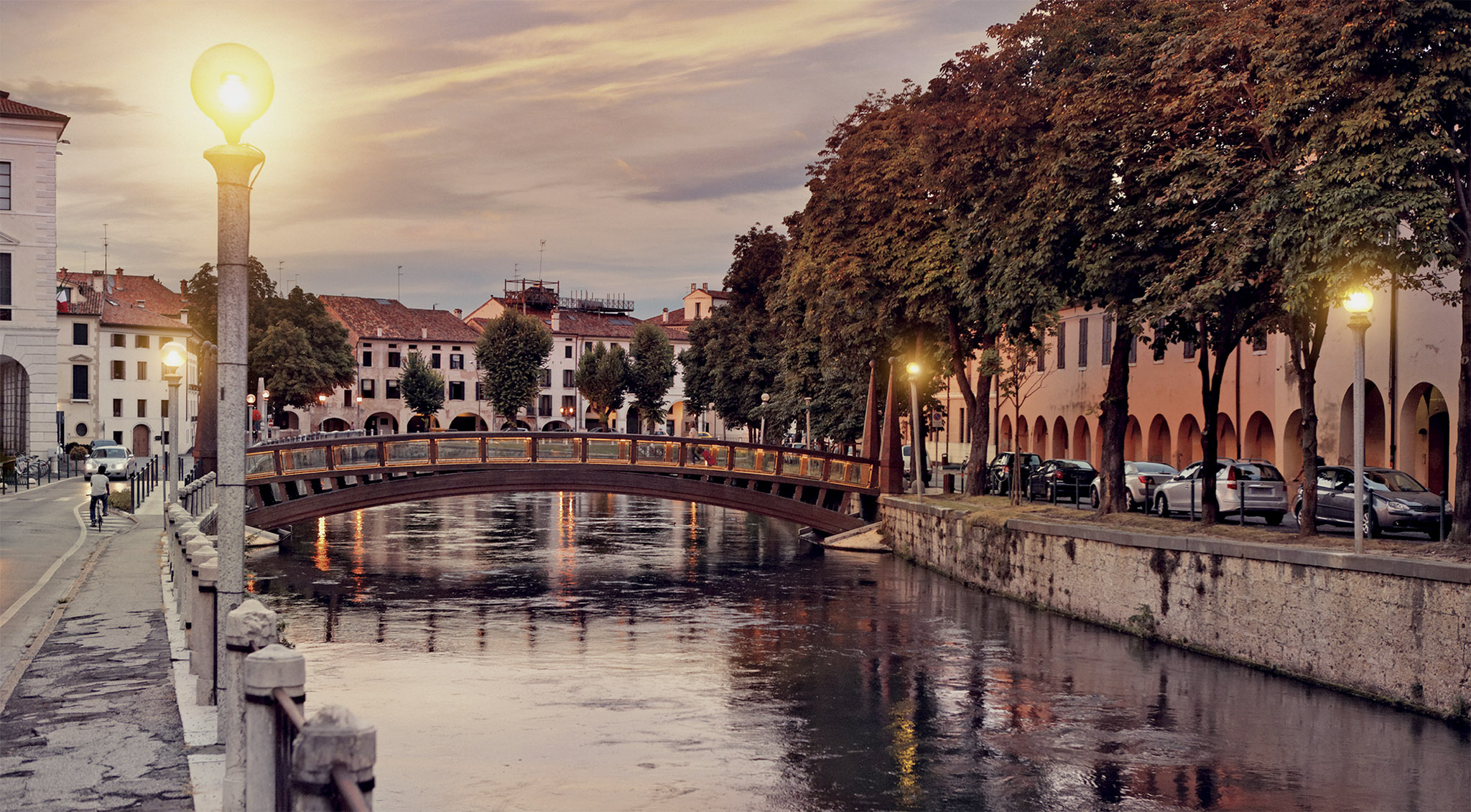
t Charming wooden bridge across the River Sile in Treviso
The conical Euganean Hills, remnants of long-extinct volcanoes, rise abruptly out of the surrounding plain. Hot-water springs bubble up at Abano Terme and Montegrotto Terme, where scores of establishments offer thermal treatments, ranging from mudbaths to immersion in the hot sulphurated waters.
' ⌂ Via Abbazia di Praglia 16, Bresseo di Teolo # Tue–Sun (pm only) ¢ Religious holidays ∑ praglia.it
The Benedictine monastery at Praglia, 6 km (4 miles) west of Abano Terme, is a peaceful haven in the hills where the monks grow herbs and restore manuscripts. They lead guided tours of parts of the abbey and the church (1490–1548), noted for its beautiful cloisters. There are also carved stalls in both the choir and the refectory, and paintings and frescoes by Zelotti, a 16th-century painter from Verona.
" = ⌂ Via Valleselle 4, Arquà Petrarca § 0429 71 82 92 # Tue–Sun (also Mon if pub hol) ¢ Public hols
The picturesque town of Arquà Petrarca, on the southern edge of the Euganean Hills, is named after Francesco Petrarca (1304–74). This medieval poet, known in English as Petrarch, spent the final years of his life here, in a house frescoed with scenes from his lyrical poems, overlooking a landscape of olive groves and vineyards. He lies buried in a simple sarcophagus in front of the church.
" = ⌂ Via Diana 2, Valsanzibio # Feb–Nov: daily ∑ valsanzibiogiardino.it
This 18th-century villa to the north of Arquà has fine Baroque gardens. Planned by Antonio Barbarigo in 1669, they are a grandiose mix of statuary, fountains, a maze, formal parterres, lakes and avenues of cypress trees.
A 30-minute train ride away, Treviso is a great base for exploring Venice – without the expensive hotels.
Over the centuries, in order to prevent the Venetian lagoon silting up, the rivers flowing into it were diverted. The River Brenta was canalized in two sections: the older branch, between Padua and Fusina (just west of Venice), dates back to the 1500s and flows for 36 km (22 miles). Its potential as a transport route was quickly realized and fine villas were built along its length. Many of these elegant buildings can still be admired today – the S11 road runs alongside most of the canal’s length – and several of them are open to the public.
The 18th-century Villa Pisani at Strà has an extravagant frescoed ceiling by Tiepolo. The Barchessa Valmarana at Mira boasts 18th-century decorations. In the village of Malcontenta is Villa Foscari, or Villa Malcontenta, one of Palladio’s loveliest villas. It was built in 1560 and the interior features frescoes by Zelotti.
" ' = ⌂ Via Pisani, Strà # Tue–Sun ¢ 1 Jan, 1 May, 25 Dec ∑ villapisani.beniculturali.it
" ⌂ Via Valmarana 11, Mira # 10am–4:30pm Tue–Sun (Mar–Oct: to 6pm) ∑ villavalmarana.net
" ⌂ Via dei Turisti 9, Malcontenta # Tue & Sat am ¢ Nov–Mar ∑ lamalcontenta.com
|
STAY Maison Matilda This hotel in a 19th-century palazzo has six individually designed rooms. The “Charming” room has parquet floors and a four-poster bed. An all-day breakfast is served in a peaceful courtyard. ⌂ Via Jacopo Riccati, Treviso∑ maisonmatilda.com ¡¡¡ |

t Charming wooden bridge across the River Sile in Treviso
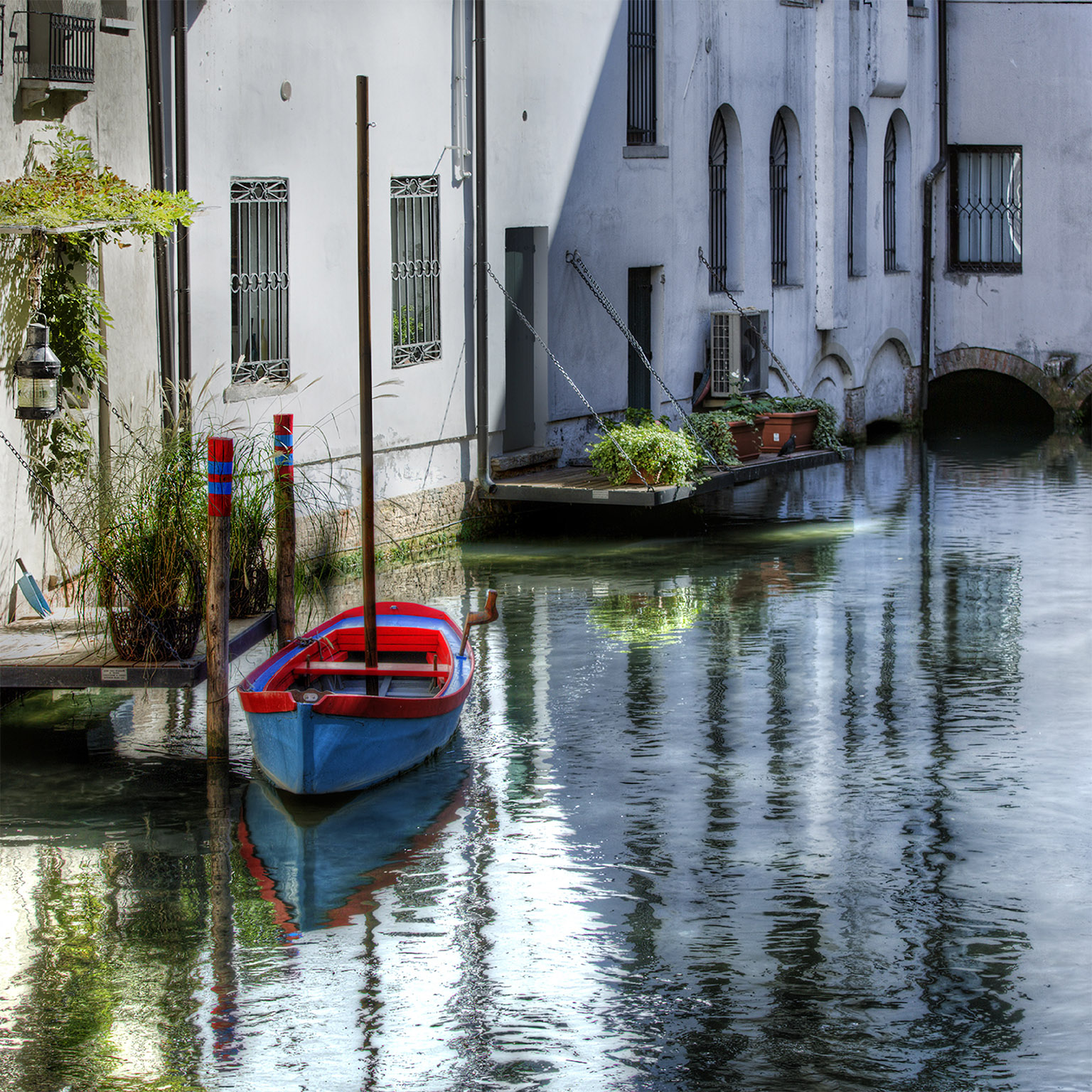
t A boat moored by a small pier on a canal in Treviso
A good place to start a tour of the fortified city of Treviso is Calmaggiore. The street links the 13th-century Palazzo dei Trecento town hall with the Duomo, which was founded in the 1100s but rebuilt several times. Inside the Duomo, Titian’s Annunciation (1570) vies for attention with the striking Adoration of the Magi fresco (1520) by Il Pordenone. More paintings by Titian and other Renaissance artists may be seen in the Museo Civico.
Open mornings from Tuesday to Saturday, the city's bustling fish market is held on a picturesque island in the middle of Treviso’s River Sile.
The church of San Nicolò, by the 16th-century city wall, contains interesting frescoes, including, on a wall of the chapterhouse, the first ever depiction of spectacles in art.
" ⌂ Chiesa Santa Caterina, Piazzetta Mario Botter 1 # Tue–Sun ¢ Public hols ∑ museicivicitreviso.it
⌂ Via San Nicolò § 0422 54 86 26 # Daily
|
DRINK Bar Beltrame Piazza bars aren’t to everyone's taste, but Bar Beltrame is so charming that it’s impossible not to stop by. Wicker seats are crowded under cool stone arches, where stylish locals gather in the evening for a Campari spritz or glass of prosecco. Mini-sandwiches and bowls of crisps are complimentary. ⌂ Piazza dei Signori, Treviso § 0422 54 07 89 ¢ Thu |
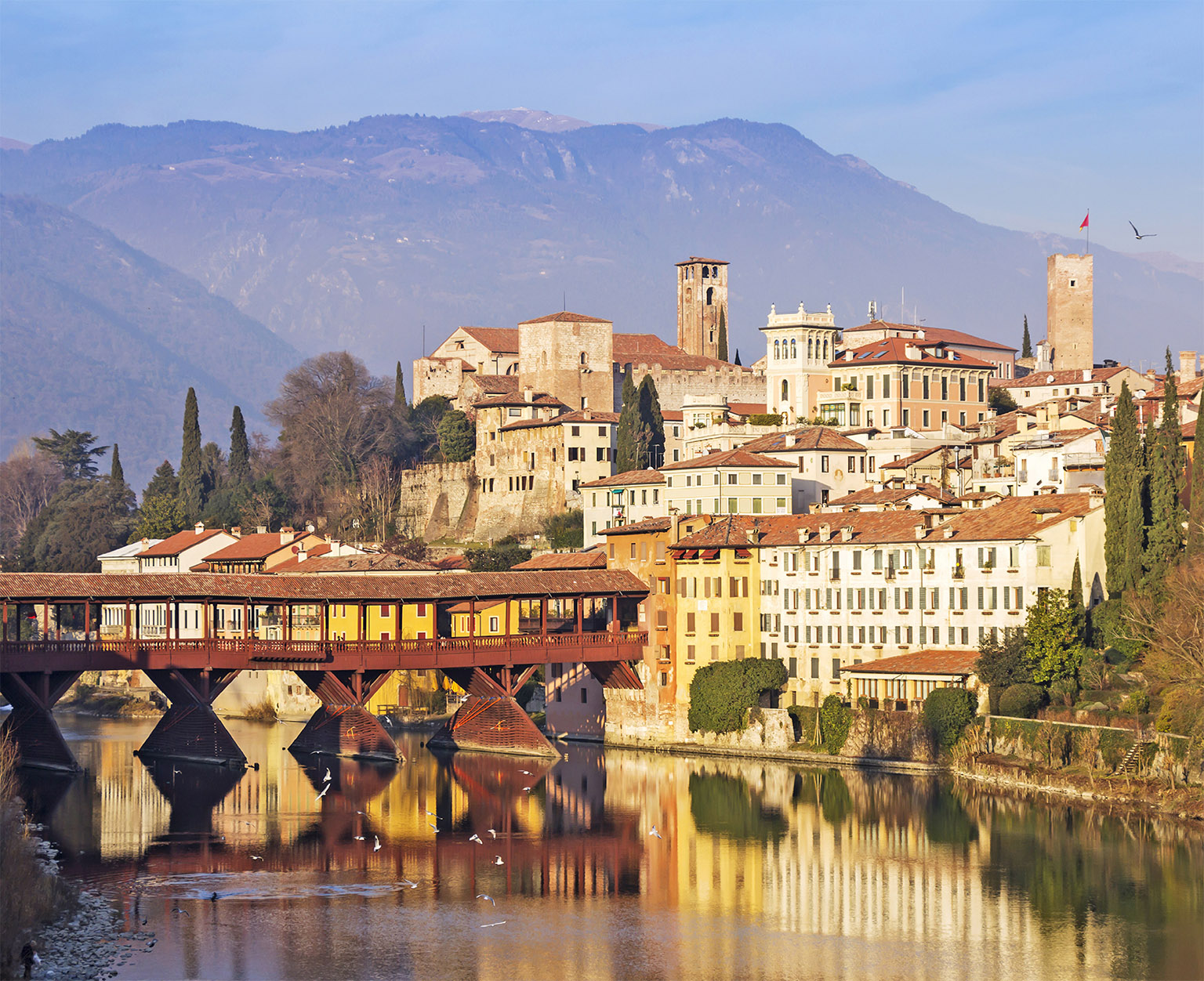
t Bassano del Grappa’s Ponte degli Alpini, designed by Andrea Palladio
This peaceful town lies at the foot of Monte Grappa. The River Brenta is straddled by the graceful Ponte degli Alpini, designed in 1569 by Palladio. It is built of timber to allow it to flex when hit by the spring meltwaters. Bassano is well known for its majolica products (decorated and glazed earthenware), some of which are on display in the Palazzo Sturm. The town is also synonymous with the popular Italian clear spirit known as grappa. It is produced from the lees (graspa) left over from wine production. Information about the process, and also about the impact of World War I in the area, is given in the Museo degli Alpini.
" ⌂ Via Schiavonetti # Mon & Wed–Sat ∑ museibassano.it
- = ⌂ Via Angarano 2 # Tue–Sun ∑ museibassano.it
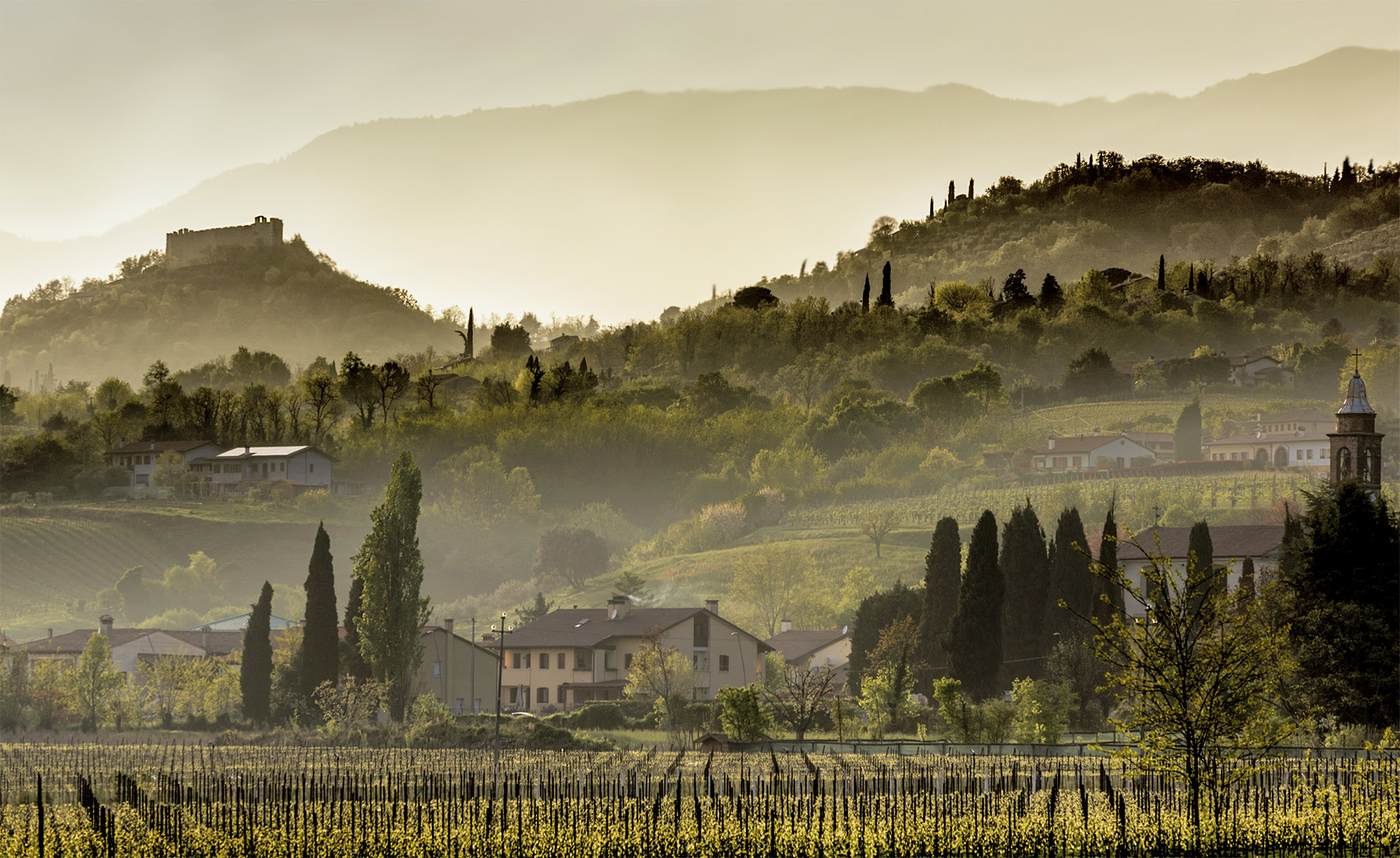
t Cypress-clad hills around the walled town of Asolo
This tiny walled town was once ruled by Queen Caterina Cornaro (1454–1510), the Venetian wife of the King of Cyprus, who poisoned her husband so that Venice would gain Cyprus. Cardinal Pietro Bembo, a poet, coined the verb asolare to describe the bittersweet life of enforced idleness she endured in exile here. Among others who fell in love with the place was poet Robert Browning, who named a volume of poems Asolanda (1889) after Asolo.
At Maser, 10 km (6 miles) east of the town, stands the magnificent Villa Barbaro. It was designed by Palladio in about 1555, in conjunction with the artist Veronese, and perfectly blends symmetry and light, airy rooms with sumptuous trompe l’oeil frescoes.
" ⌂ Maser # Apr–Oct: 11am–5pm Tue–Sun; Nov–Mar: 11am–5pm Sat, Sun & pub hols ¢ 1 Jan, Easter Sun, 25 Dec ∑ villadimaser.it
The historic core of this town lies within well-preserved walls. The Casa di Giorgione, said to be the birthplace of the painter Giorgione (1478–1511), houses a museum devoted to his life. Giorgione innovatively used landscape to create mood, as can be seen in his most famous work, the broodingly mysterious and evocative Tempest.
About 8 km (5 miles) northeast of the town, at Fanzolo, lies the pretty Villa Emo (c.1555). Designed by Palladio, it is a typical example of his work: a cube flanked by two symmetrical wings. Inside there are lavish frescoes by Zelotti.
" ⌂ Piazza San Liberale # Tue–Sun ¢ Public hols ∑ museocasagiorgione.it
" = ⌂ Via Stazione 5, Fanzolo # Daily ¢ 1 Jan, 25 & 31 Dec ∑ villaemo.org
The Strada delle Dolomiti, or Dolomite Road, is a feat of highway construction. It enters the Veneto region via the Passo Pordoi, which at 2,239 m (7,346 ft), is the most scenic of all the Dolomite passes. From here the route follows the winding S48 for another 35 km (22 miles) east to the resort of Cortina d’Ampezzo.
There are plenty of stopping places along the route where it is possible to pause and enjoy the spectacular views. In many of the ski resorts, cable cars will carry visitors up to Alpine refuges (some with cafés attached) that are open from mid-June to mid-September. These refuges mark the start of a series of signposted walks.
Conegliano lies among prosecco-producing vineyards, and winemakers from all over Italy learn their craft at Conegliano’s renowned wine school. Via XX Settembre, the arcaded main street, is lined with fine 15th- to 18th-century palazzi, many in the Venetian Gothic style or decorated with fading frescoes. The Duomo contains the town’s one great work of art, an altarpiece painted by local artist Cima da Conegliano (1460–1518) depicting the Virgin and Child with Saints (1493).
Reproductions of Cima’s most famous works are on show in the Casa di Cima, the artist’s birthplace. The detailed landscapes in the background of his paintings were based on the hills around the town; the same views can still be seen from the gardens surrounding the ruined battlements and towers of the 10th-century Castelvecchio (old castle).
" ⌂ Via Cima 24 § 0438 224 94 # Sat & Sun, pm only and during temporary exhibitions
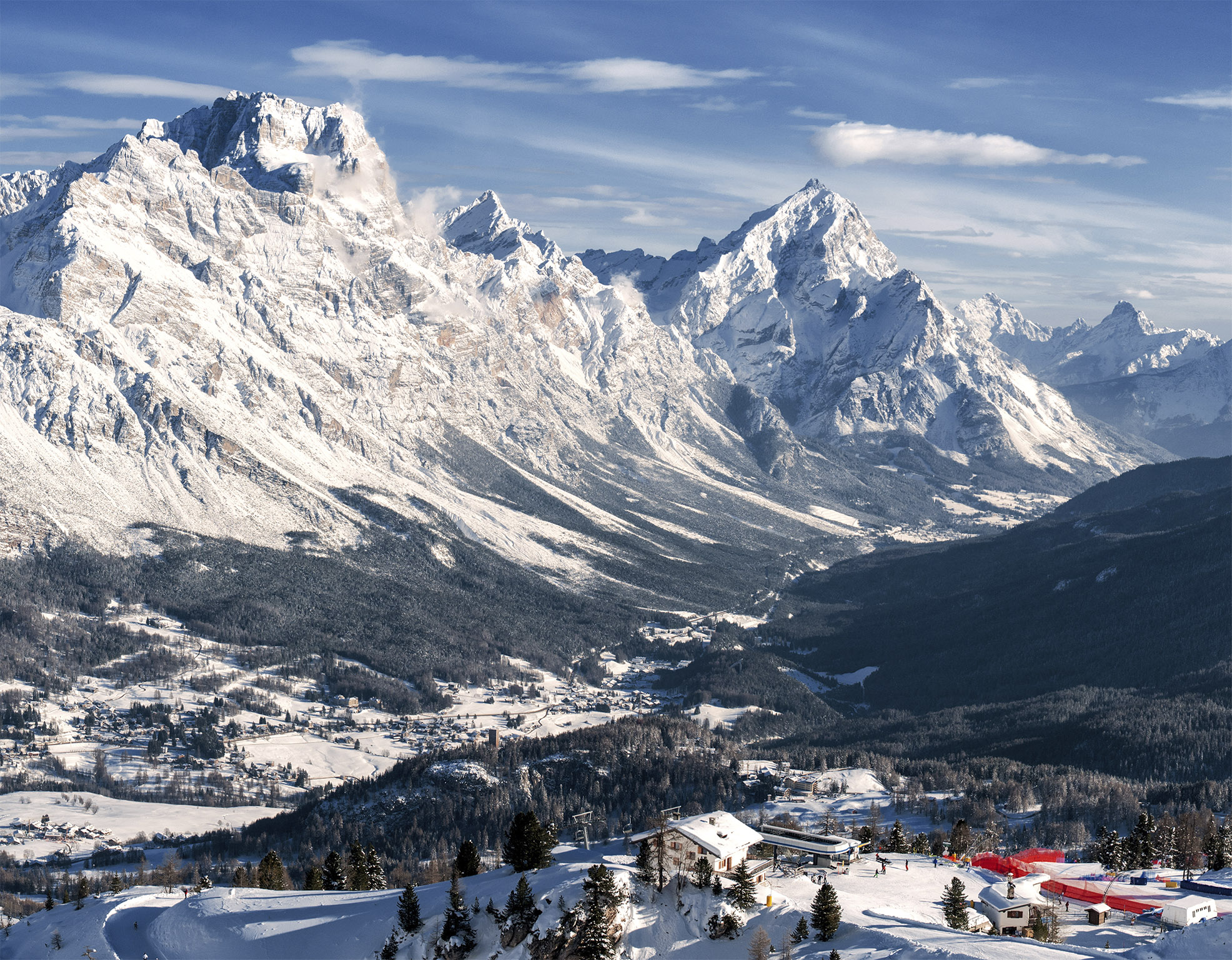
t Snowy slopes around the fashionable resort of Cortina d’Ampezzo
Italy’s top ski resort is well supplied with restaurants and bars. Cortina is set amid the dramatic scenery of the Dolomites, which explains part of its attraction: all around, crags and spires thrust their distinctive weather-beaten shapes above the trees.
Cortina has better-than-average sports facilities, thanks to hosting the 1956 Winter Olympics. In addition to downhill and cross-country skiing, there is also a ski jump and a bobsleigh run, as well as an Olympic ice stadium, swimming pools, tennis courts and riding facilities.
During the summer months, Cortina becomes an excellent base for walkers. Useful information on trails and guided walks is available from the tourist office or, during the summer, from the tour guides’ office opposite.
Experience The Veneto and Friuli
|
STAY Here are some of the best mid-range hotels in Cortina d’Ampezzo. Villa Blu Cortina Mountain chic at its best, with caramel Alpine-style furniture, plush carpets and great mountain views. ⌂ Località Verocai 73 ∑ hotelvillablucortina.it ¡¡¡ Hotel Ambra Cortina This hotel has 24 quaint Alpine rooms with wooden hues and floral drapes, some with whirlpools, spas and four-poster beds. ⌂ Via XXIX Maggio 28 ∑ hotelambracortina.it ¡¡¡ Panda A charming family-run hotel, Panda has simple but comfortable rooms. Those on the Balcony Floor have private terraces, and there’s a self-contained apartment on the top floor. ⌂ Via Roma 64 ∑ cortinahotelpanda.it ¡¡¡ |
Picturesque Belluno serves as a bridge between the two different parts of the Veneto, with the flat plains to the south and the Dolomite peaks to the north. Both are encapsulated in the views to be seen from the 12th-century Porta Rugo at the southern end of Via Mezzaterra, the main street of the old town. More spectacular still are the views from the bell tower of the 16th-century Duomo (subsequently rebuilt). The nearby Baptistry houses a font cover with the figure of John the Baptist carved by Andrea Brustolon (1662–1732). Brustolon’s works also grace the churches of San Pietro (on Via San Pietro) and Santo Stefano (Piazza Santo Stefano). North of Piazza del Duomo stands the elegant Palazzo dei Rettori (1491) – once home to the town’s Venetian rulers – and the 12th-century Torre Civica, all that now survives of a medieval castle.
The Museo Civico contains paintings by Bartolomeo Montagna (1450–1523) and Sebastiano Ricci (1659–1734), and a notable archaeological section. North of the museum is Belluno’s finest square, the Piazza del Mercato, with its arcaded Renaissance palaces and its fountain of 1410.
South of Belluno are the picturesque ski resorts of the Alpe del Nevegal; in the summer a chairlift operates from Faverghera up the flank of the mountain to a height of 1,600 m (5,250 ft), offering extensive views.
" ' = ⌂ Piazza Duomo 16 # Tue, Wed, Fri & Sat am ∑ museo.comune.belluno.it
Experience The Veneto and Friuli
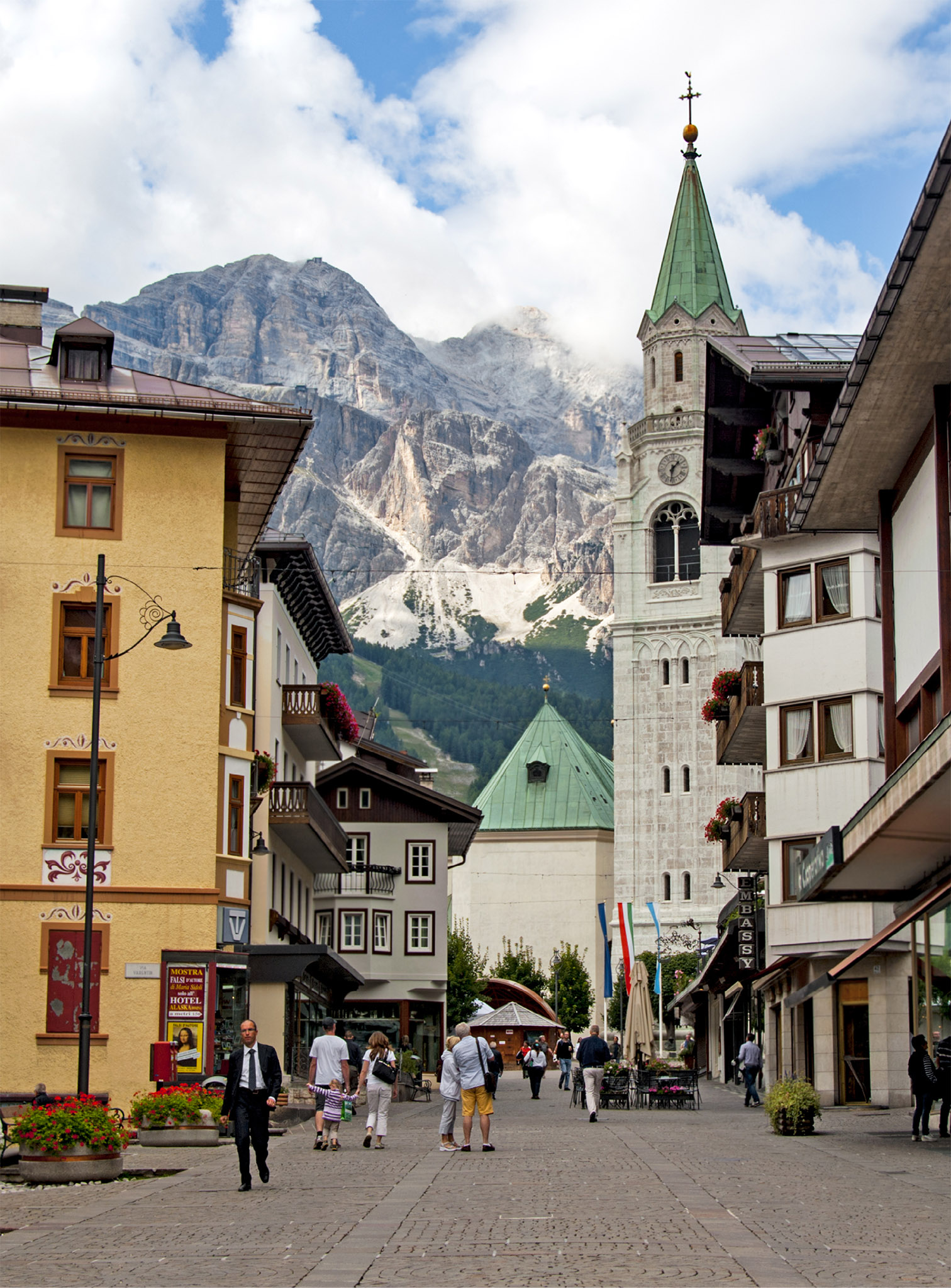
t Dramatic backdrop of the Dolomites in the charming ski resort of Cortina d’Ampezzo
Cortina is one of Italy’s most fashionable resorts. Away from the slopes, days here are spent shopping on the town’s main drag, Corso Italia, followed by cocktails at Bar Arnika (Corso Italia 983) or a local prosecco at wine bar Enoteca (Via del Mercato 5). Anyone wanting something a bit more substantial will love wine-and-cured-meats bar Dok Dall’Ava LP 26 (Largo delle Poste 26). The best city-centre après-ski happens at Birreria Hacker Pschorr (Via Stazione 7), followed by dancing at VIP club (Corso Italia 207).
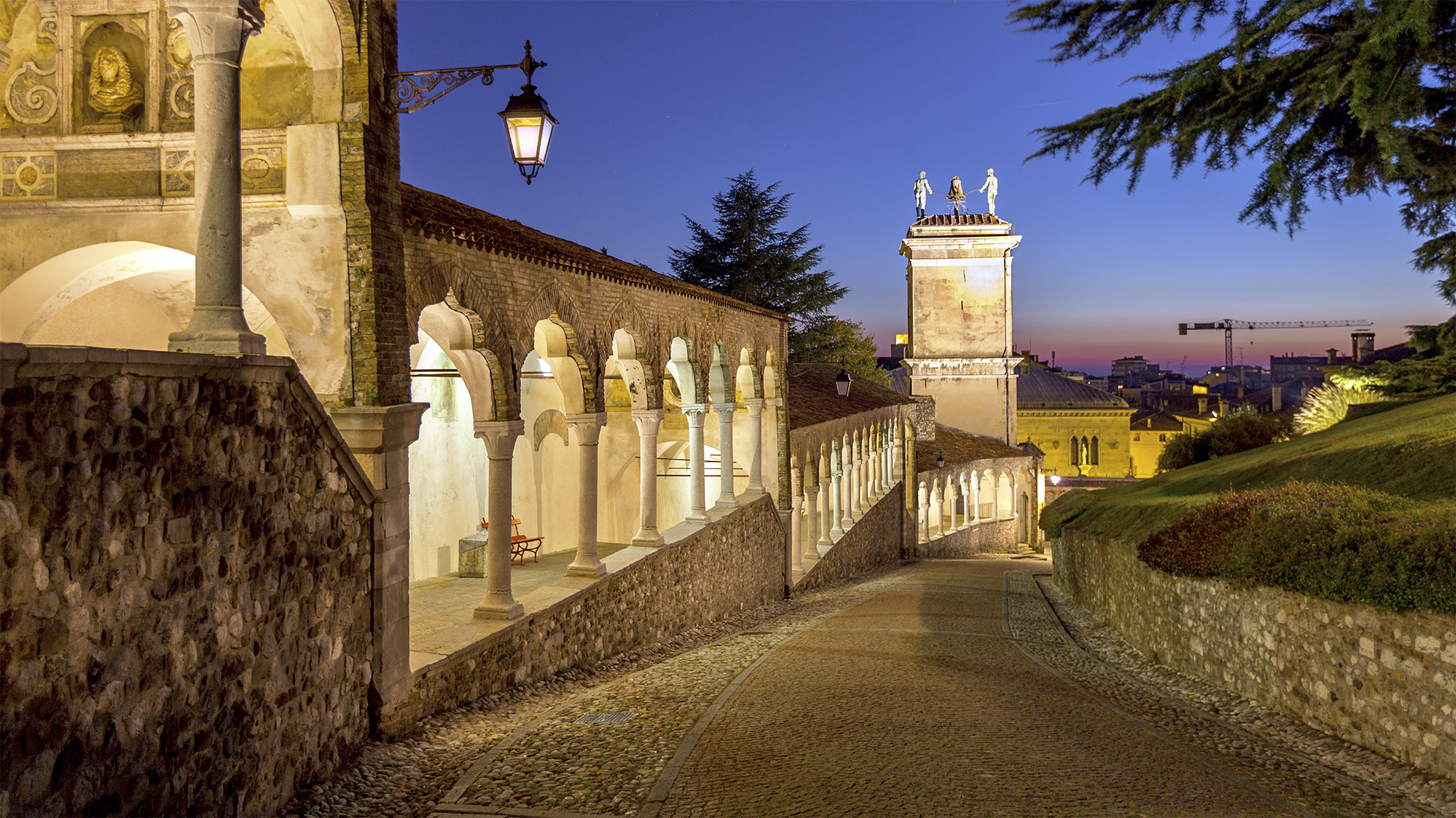
t A Venetian Gothic loggia in Udine, a city known for its eclectic architecture
Udine is a city of varied and surprising architecture. In the central Piazza della Libertà, the Loggia del Lionello (1448–56), built of pink stone in Venetian Gothic style, stands beside the Art Deco Caffè Contarena. Opposite, the Renaissance symmetry of the Porticato di San Giovanni is interrupted by the Torre dell’Orologio (Clock Tower, 1527), crowned by two bronze Moors that strike every hour. Note also the fountain of 1542, the two 18th-century statues, and the column supporting the Lion of St Mark.
Beyond the Arco Bollani, a gateway designed by Palladio in 1556, steps lead up to a 26-m (85-ft) hill that offers sweeping views over the city. On the hill is the 16th-century castle, now the Musei Civici e Galleria di Storia e Arte Antica, which houses fine art and archaeology collections.
Southeast of Piazza Matteotti, at the end of Via Savorgnana (where a small market is held), stands the Oratorio della Purità, and the Duomo with its octagonal bell tower. Both contain important paintings and frescoes by Giambattista Tiepolo (1696–1770). More of Tiepolo’s work can be seen in the Museo Diocesano e Galleria Tiepolo, formerly the Palazzo Arcivescovile, which the artist decorated with frescoes.
Outside Codroipo, 24 km (15 miles) west, rises the imposing Villa Manin. A road passes through its grounds, so it can be seen even when the house – once the retreat of Ludovico Manin, the last doge of Venice (1725–1802) – and its gardens are closed.
" ⌂ Castello di Udine § 0432 27 15 91 # Tue–Sun ¢ 1 Jan, Easter, 1 May, 25 Dec
= " ⌂ Piazza Patriarcato 1 § 0432 29 80 56 # Wed–Mon ¢ 1 Jan, Easter, 25 Dec
" ⌂ Piazza del Doge, Passariano § 0432 82 12 10 # Tue–Sun for exhibitions only ¢ 1 Jan, 25 Dec
Experience The Veneto and Friuli
|
EAT Rosenbar This family-run place offers a great seasonal tasting menu. In summer you can eat on a terrace. ⌂ Via Duca d’Aosta 96, Gorizia ∑ rosenbar.it ¡¡¡ Al Piave A homely trattoria serving local dishes such as stewed beef. Excellent local wine list. ⌂ Via Cormons 6, Gorizia ∑ trattoriaalpiave.it ¡¡¡ Ca di Pieri A popular eatery specializing in simple dishes such as gnocchi and minestrone, plus crepes with apricot jam. ⌂ Via Piero Antonio Codelli 5, Gorizia § 0481 53 33 08 ¡¡¡ |
Experience The Veneto and Friuli
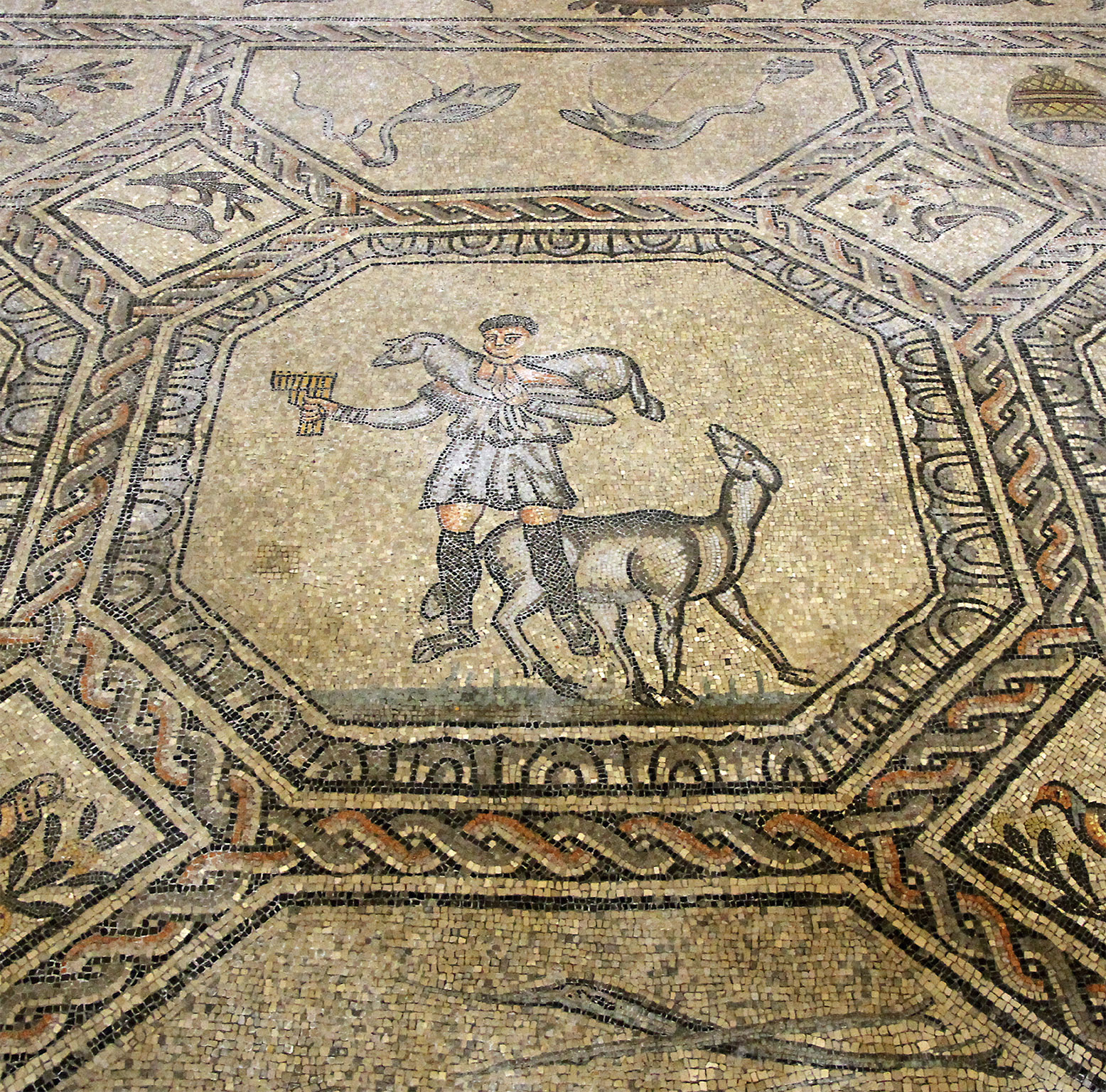
Christians were persecuted until AD 313, when their religion was granted official status by Constantine the Great. Prior to this they had developed a language of symbols – like the fish, or ICHTHUS (an acronym for Iesous CHristos THeou Uios Soter – Jesus Christ, Son of God, Saviour, in ancient Greek) to express their beliefs. Many of these symbols can be seen in the mosaics and marble tomb chests of Aquileia.
Aquileia, now little more than a village but encircled by the ruins of palatial villas, baths, temples and market buildings, provides a poignant reminder of the lost splendour of the Roman Empire.
It was here that Emperor Augustus received Herod the Great, King of Judea, in 10 BC, and it was here, too, in AD 381, that the early Christian church held a major council to settle doctrinal issues. In the 5th century, however, the town was abandoned following several sackings.
On a group of low islands in the Adriatic lagoon, attached to the mainland by a narrow causeway, Grado grew into a port for Aquileia in the 2nd century and was used as a haven during the barbarian invasions. Today, it is a popular seaside resort. At the centre of the old town is the Duomo, which contains 6th-century frescoes in the apse. Nearby, in the church of Santa Maria delle Grazie, there are more 6th-century mosaics.
" ⌂ Piazza Capitolo § 0431 91 97 19 # Daily ¢ During Mass
The Basilica was founded in about AD 313 and much of the original structure still survives, including the floor mosaics of the nave and Cripta degli Scavi below. The designs mix biblical stories and scenes from everyday life. There is a lively portrayal of the tale of Jonah, who was swallowed by a sea monster.
" ⌂ Via Roma 1 # Tue–Sun ∑ museoarcheologicoaquileia.beniculturali.it
Mosaics and stone carvings from the 1st to 3rd centuries are on display here, along with glass, amber and a collection of flies, beautifully worked in gold, that formed the adornment of a Roman matron’s veil.
⌂ Località Monastero § 0431 911 31 # 8:30am–1:45pm Tue–Sun
This museum, which stands not far from Aquileia’s ancient harbour beside the once navigable River Natissa, focuses on the development of art during the early Christian era.
Gorizia was at the centre of fierce fighting during both world wars and was split in two by the 1947 Treaty of Paris, leaving part in Italy, part in Yugoslavia (now Slovenia).
The Museo Provinciale della Grande Guerra (Museum of the Great War), in the basement of the Museo Provinciale di Storia e Arte, has videos, photographs, and mock-ups of trenches, latrines and gun emplacements showing the waste, squalor and heroism of war.
On a mound nearby rises the castle, encircled by 16th-century fortifications. From here there are views over the town.
Southwest of Gorizia, scenic country roads pass through the foothills of the Carso, a limestone plateau gouged with tunnels, caves and underground rivers.
" ⌂ Borgo Castello 13 § 0481 53 39 26 # Tue–Sun ¢ 25 Dec
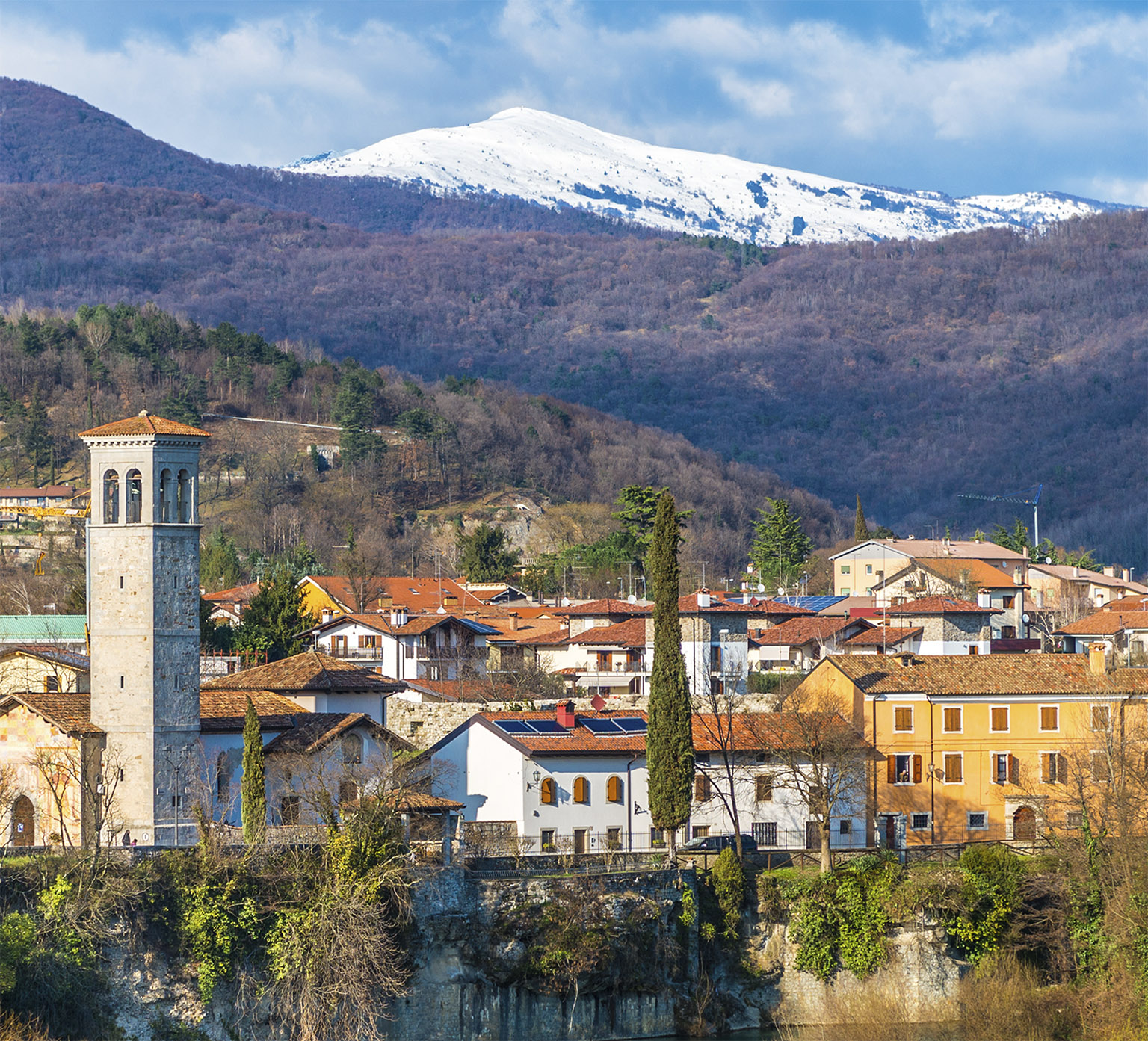
t Cividale del Friuli, surrounded by forested mountains
A gate in the medieval walls of Cividale leads to the dramatic ravine of the River Natisone, which is spanned by the Ponte del Diavolo (Devil’s Bridge). Above the river’s north bank is the Tempietto Longobardo (Lombardic Chapel), an 8th-century church decorated with reliefs of saints, modelled in stucco. The town’s history is traced in the excellent Museo Archeologico Nazionale, which contains the excavated remains of buildings from a Roman town, and a collection of Lombardic items including jewellery, ivory and weapons.
Next door is the Duomo, rebuilt in 1453 after a fire, with its beautiful silver altarpiece (13th century). The Museo Cristiano, off the south aisle, contains sculptures from the original church, like the altar donated by Ratchis, the Lombardic Duke of Friuli and later King of Italy (737–44), which is finely carved with scenes from the Life of Christ.
" ⌂ Via Monastero Maggiore 34 § 0432 70 08 67 # Daily
" ⌂ Palazzo dei Provveditori Veneti, Piazza del Duomo 13 § 0432 70 07 00 # Daily (am only Mon) ¢ 1 Jan, 1 May, 25 Dec
" ⌂ Via Condotti 1 # Wed–Sun ¢ 1 Jan, 25 Dec ∑ mucris.it
An important port during the Roman Empire, this lagoon city became part of Austria in 1815, returning to Italy only after World War II. Today Grado is a pleasant resort, with clean beaches and a lively city centre. The Basilica of Sant’Eufemia features beautifully preserved 6th-century mosaics.
Grado is also a popular spa destination, and it offers outdoor activities such as tennis, sailing and golf.
Experience The Veneto and Friuli
|
EAT Al Bagatto Come here for the exceptional seafood-based tasting menu. Sophisticated, beautifully presented dishes are served in an intimite, refined dining room. ⌂ Via Luigi Cadorna 7, Trieste ∑ albagatto.it ¡¡¡ Scabar The menu here is exceptional, with all ingredients sourced locally. Nab a table on the terrace and order the ravioli with prawns, followed by the grilled catch of the day. ⌂ Via Erta di Sant'Anna 63, Trieste ∑ scabar.it ¡¡¡ |
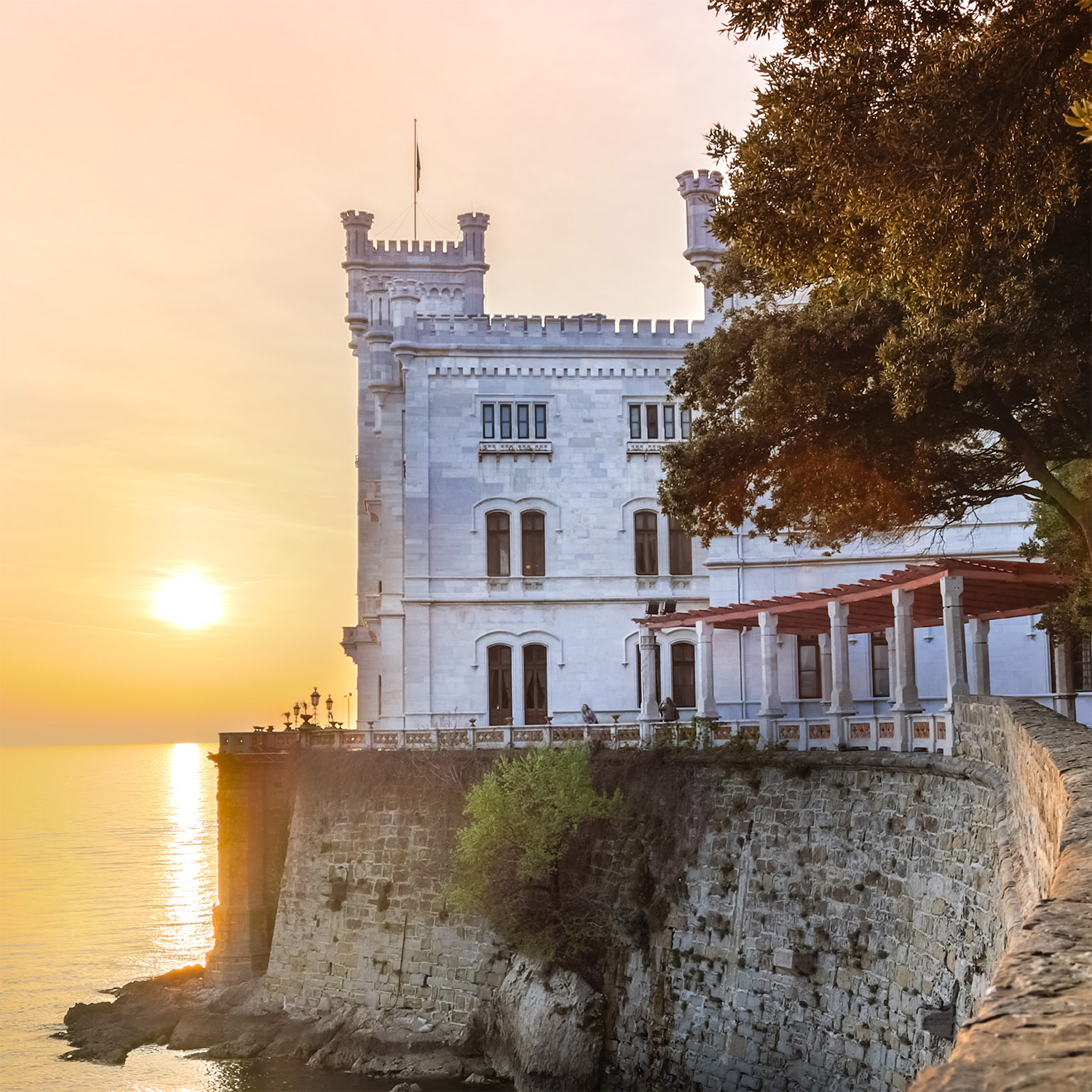
t The 19th-century Castello di Miramare, at Grignano, near Trieste
A limestone plateau cutting a swathe through northeastern Italy, the Carso region is utterly unique. Its features include a cliffside series of villages with some of the oldest and largest caves in the world, as well as forests, gorges, lakes, rivers and views to the Adriatic – all of them drawing keen hikers and cyclists to the region.
There are 100 settlements in the Carso, some of which can be reached from Trieste in just 25 minutes, thanks to regular bus services.
Heading north from Italy, country roads stretch into the Slovenian hills, passing churches, wineries, rivers and farmhouses.

t Elegant buildings lining the lively harbour of Trieste
Trieste is an atmospheric city with a long, bustling harbour lined with handsome build-ings and lapped by the waves of the Adriatic Sea.
From Villa Opicina, just to the north, there are sweeping views over the city, its bay and the coast of Slovenia.
" ⌂ Molo Pescheria 2, Riva Nazario Sauro 1 § 040 30 62 01 # 9am–5pm Thu–Tue (May–Sep: to 7pm)
This small aquarium contains examples of the fascinating marine life in the Adriatic. On the upper floor is a vivarium filled with local and exotic reptiles and amphibians.
" ⌂ Piazza Cattedrale 3 § 040 30 93 62 # 10am–5pm Tue–Sun (May–Sep: to 7pm)
Up above the harbour stands a hilltop castle built by Trieste’s Venetian governors from 1368. It is set on a terrace that offers views over the Gulf of Trieste. The castle houses two museums containing Roman mosaics and a collection of weapons and armour.
⌂ Via Madonna del Mare 11 § 040 426 14 11 # 10am–noon Wed
Beside the Castello di San Giusto lie the substantial ruins of the Roman Basilica (or law court) built around AD 100. Note the stone magistrates’ bench and throne.
⌂ Piazza Cattedrale 2 § 040 322 45 75 # Daily
Trieste's Duomo is built on the site of a 5th-century Christian basilica and two 9th-century churches. The churches were merged in the 14th century, leaving the cathedral with two apses and an asymmetrical façade. Highlights include the Gothic rose window, the bell tower (which incorporates Romanesque debris from the earlier buildings), and the two 13th-century Venetian-style apse mosaics.
" ⌂ Pza della Cattedrale 1 § 040 31 05 00 # Tue–Sun (Nov–Mar: daily)
This archaeological collection documents Trieste’s trade links with ancient Greece.
' " ⌂ Borgo Grotta Gigante 42a § 040 32 73 12 # Tue–Sun (Jul & Aug: daily)
Beyond the city lies this huge cavern filled with a series of tall stalagmites that resemble organ pipes in their formation.
" ⌂ Viale Miramare, Grignano § 040 22 41 43 # Daily
At Grignano, 8 km (5 miles) northwest of the city, stands this castle set in lush gardens. It was built as a summer retreat by the Archduke Maximilian in 1856–60, a few years before he was assassinated in Mexico.